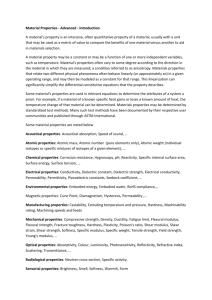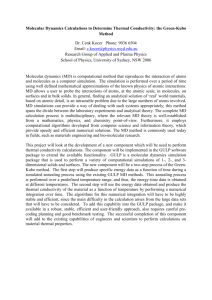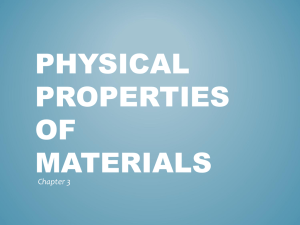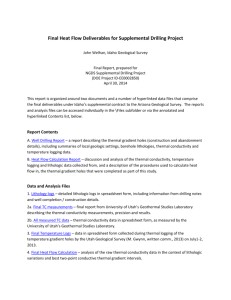The Effect of Microstructure on the Thermal Conductivity of Silicon
advertisement
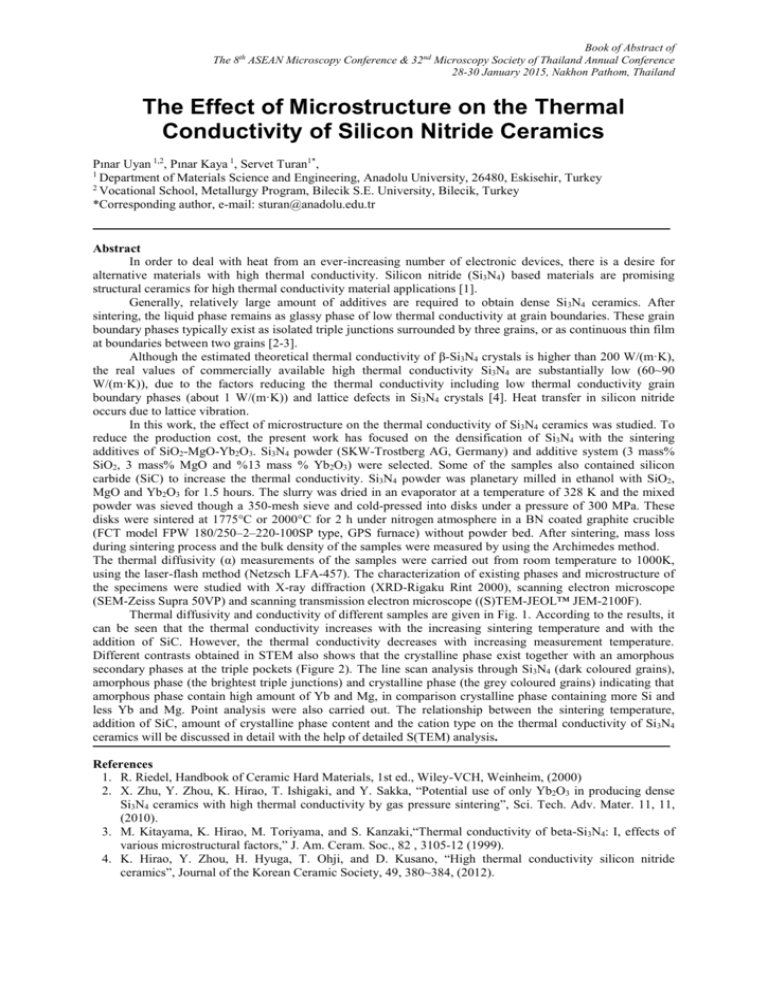
Book of Abstract of The 8th ASEAN Microscopy Conference & 32nd Microscopy Society of Thailand Annual Conference 28-30 January 2015, Nakhon Pathom, Thailand The Effect of Microstructure on the Thermal Conductivity of Silicon Nitride Ceramics Pınar Uyan 1,2, Pınar Kaya 1, Servet Turan1*, 1 Department of Materials Science and Engineering, Anadolu University, 26480, Eskisehir, Turkey 2 Vocational School, Metallurgy Program, Bilecik S.E. University, Bilecik, Turkey *Corresponding author, e-mail: sturan@anadolu.edu.tr Abstract In order to deal with heat from an ever-increasing number of electronic devices, there is a desire for alternative materials with high thermal conductivity. Silicon nitride (Si3N4) based materials are promising structural ceramics for high thermal conductivity material applications [1]. Generally, relatively large amount of additives are required to obtain dense Si 3N4 ceramics. After sintering, the liquid phase remains as glassy phase of low thermal conductivity at grain boundaries. These grain boundary phases typically exist as isolated triple junctions surrounded by three grains, or as continuous thin film at boundaries between two grains [2-3]. Although the estimated theoretical thermal conductivity of β-Si3N4 crystals is higher than 200 W/(m·K), the real values of commercially available high thermal conductivity Si3N4 are substantially low (60~90 W/(m·K)), due to the factors reducing the thermal conductivity including low thermal conductivity grain boundary phases (about 1 W/(m·K)) and lattice defects in Si3N4 crystals [4]. Heat transfer in silicon nitride occurs due to lattice vibration. In this work, the effect of microstructure on the thermal conductivity of Si3N4 ceramics was studied. To reduce the production cost, the present work has focused on the densification of Si3N4 with the sintering additives of SiO2-MgO-Yb2O3. Si3N4 powder (SKW-Trostberg AG, Germany) and additive system (3 mass% SiO2, 3 mass% MgO and %13 mass % Yb2O3) were selected. Some of the samples also contained silicon carbide (SiC) to increase the thermal conductivity. Si3N4 powder was planetary milled in ethanol with SiO2, MgO and Yb2O3 for 1.5 hours. The slurry was dried in an evaporator at a temperature of 328 K and the mixed powder was sieved though a 350-mesh sieve and cold-pressed into disks under a pressure of 300 MPa. These disks were sintered at 1775°C or 2000°C for 2 h under nitrogen atmosphere in a BN coated graphite crucible (FCT model FPW 180/250–2–220-100SP type, GPS furnace) without powder bed. After sintering, mass loss during sintering process and the bulk density of the samples were measured by using the Archimedes method. The thermal diffusivity (α) measurements of the samples were carried out from room temperature to 1000K, using the laser-flash method (Netzsch LFA-457). The characterization of existing phases and microstructure of the specimens were studied with X-ray diffraction (XRD-Rigaku Rint 2000), scanning electron microscope (SEM-Zeiss Supra 50VP) and scanning transmission electron microscope ((S)TEM-JEOL™ JEM-2100F). Thermal diffusivity and conductivity of different samples are given in Fig. 1. According to the results, it can be seen that the thermal conductivity increases with the increasing sintering temperature and with the addition of SiC. However, the thermal conductivity decreases with increasing measurement temperature. Different contrasts obtained in STEM also shows that the crystalline phase exist together with an amorphous secondary phases at the triple pockets (Figure 2). The line scan analysis through Si3N4 (dark coloured grains), amorphous phase (the brightest triple junctions) and crystalline phase (the grey coloured grains) indicating that amorphous phase contain high amount of Yb and Mg, in comparison crystalline phase containing more Si and less Yb and Mg. Point analysis were also carried out. The relationship between the sintering temperature, addition of SiC, amount of crystalline phase content and the cation type on the thermal conductivity of Si3N4 ceramics will be discussed in detail with the help of detailed S(TEM) analysis. References 1. R. Riedel, Handbook of Ceramic Hard Materials, 1st ed., Wiley-VCH, Weinheim, (2000) 2. X. Zhu, Y. Zhou, K. Hirao, T. Ishigaki, and Y. Sakka, “Potential use of only Yb2O3 in producing dense Si3N4 ceramics with high thermal conductivity by gas pressure sintering”, Sci. Tech. Adv. Mater. 11, 11, (2010). 3. M. Kitayama, K. Hirao, M. Toriyama, and S. Kanzaki,“Thermal conductivity of beta-Si3N4: I, effects of various microstructural factors,” J. Am. Ceram. Soc., 82 , 3105-12 (1999). 4. K. Hirao, Y. Zhou, H. Hyuga, T. Ohji, and D. Kusano, “High thermal conductivity silicon nitride ceramics”, Journal of the Korean Ceramic Society, 49, 380~384, (2012). Book of Abstract of The 8th ASEAN Microscopy Conference & 32nd Microscopy Society of Thailand Annual Conference 28-30 January 2015, Nakhon Pathom, Thailand Figure 1. (a) Thermal diffusivity and (b) thermal conductivity of Si3N4 ceramics sintered at different temperatures and with the addition of SiC. Figure 2. STEM image showing the existence of crystalline and amorphous secondary phases. Figure 3. STEM line scan analysis through crystalline and amorphous secondary phases


